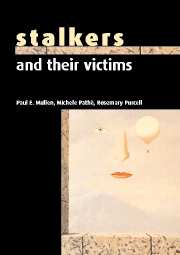Book contents
- Frontmatter
- Contents
- Acknowledgements
- Introduction
- 1 Stalking – a new categorization of human behaviour
- 2 The epidemiology of stalking
- 3 The victims of stalkers
- 4 Classifying stalkers
- 5 The rejected stalker and the resentful stalker
- 6 The predatory stalker
- 7 Intimacy seekers and incompetent suitors
- 8 The erotomanias and the morbid infatuations
- 9 Same gender stalking
- 10 Stalking by proxy
- 11 False victims of stalking
- 12 Stalking and assault
- 13 Reducing the impact of stalking
- 14 Defining and prosecuting the offence of stalking
- 15 Assessing and managing the stalker
- Appendix A Victim services
- Appendix B Important anti-stalking Acts/statutes
- Legal cases and references
- Index
13 - Reducing the impact of stalking
Published online by Cambridge University Press: 05 March 2012
- Frontmatter
- Contents
- Acknowledgements
- Introduction
- 1 Stalking – a new categorization of human behaviour
- 2 The epidemiology of stalking
- 3 The victims of stalkers
- 4 Classifying stalkers
- 5 The rejected stalker and the resentful stalker
- 6 The predatory stalker
- 7 Intimacy seekers and incompetent suitors
- 8 The erotomanias and the morbid infatuations
- 9 Same gender stalking
- 10 Stalking by proxy
- 11 False victims of stalking
- 12 Stalking and assault
- 13 Reducing the impact of stalking
- 14 Defining and prosecuting the offence of stalking
- 15 Assessing and managing the stalker
- Appendix A Victim services
- Appendix B Important anti-stalking Acts/statutes
- Legal cases and references
- Index
Summary
Introduction
The clinical studies reviewed in Chapter 3 demonstrate the destructive impact of stalking on its victims. Being stalked can induce depression, anxiety and chronic stress. The syndrome of posttraumatic stress disorder (PTSD) has been used here, as in so many areas of trauma and victimization, to describe and delineate the psychological sequelae of stalking. PTSD offers a label that encompasses the increased fear and arousal experienced by many victims, the deliberate avoidance of reminders of the harassment, and intrusive re-experiencing phenomena such as nightmares. Given the frequency with which stalking victims report such symptoms, the focus in this chapter is on the clinical management of these forms of psychological disturbance.
The efficacy of supportive, cognitive behavioural and pharmacological therapies in the treatment of traumatic stress has been reported, particularly for those individuals exposed to combat, sexual assault or natural disasters (for comprehensive reviews see Shalev et al., 1996; Foa & Meadows, 1997). To our knowledge, however, the utility of these treatments in the management of stalking victims has yet to receive empirical support. Unlike other forms of traumatic stress that involve lifethreatening but relatively circumscribed events, stalking can present a more complex dynamic for the clinician as victims experience repeated and often prolonged trauma. The situation is akin to that of victims of domestic violence and, like them, stalking victims may present to health professionals during the course of their victimization.
- Type
- Chapter
- Information
- Stalkers and their Victims , pp. 221 - 248Publisher: Cambridge University PressPrint publication year: 2000



